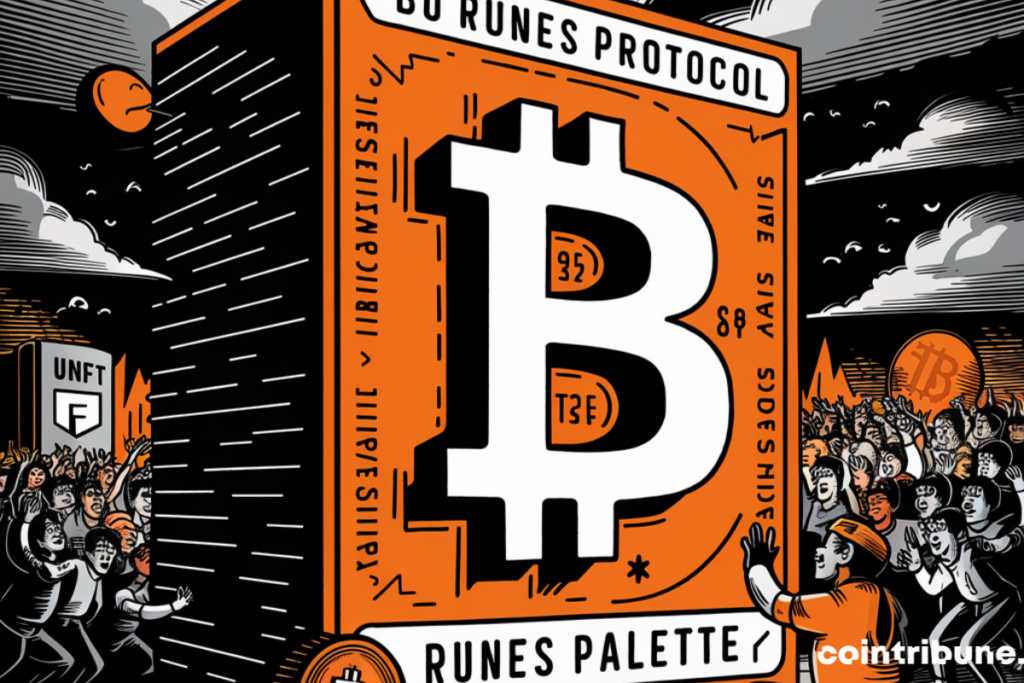Runes Dominates Bitcoin Transactions, Securing 68% of the Network
Since its launch during the Halving on April 20, the Runes protocol has swept through the Bitcoin blockchain, capturing more than 68% of the transactions. This rapid adoption is sparking as much excitement as it is questions about the future of the network.

A rapid adoption driven by the market’s euphoria
The rollout of Runes coincided with the highly anticipated “Halving”, cutting mining rewards in half. Since then, this new token standard has seen a meteoric rise on the Bitcoin blockchain.
According to on-chain metrics from Dune Analytics, as relayed by Crypto Koryo analytics firm, Runes already account for over 2.38 million transactions, which is 68% of the activity recorded on the network since April 20. The peak was reached on April 23, with more than 750,000 transactions in 24 hours, before a consolidation around 312,000 the following day.
This enthusiasm can be explained in particular by the rush of memecoin enthusiasts and NFT collectors, looking to mint “rare satoshis” via the Runes protocol, thus riding the speculative wave post-Halving.
As a direct consequence of this influx: Runes transactions drained nearly 70% of the mining fees on the day of the Halving. Despite a gradual compression, fluctuating between 33% and 69% in the following days, the impact of Runes on the dynamics of the Bitcoin ecosystem is undeniable.
Runes, a new economic model for miners?
While Runes have undoubtedly energized activity on the Bitcoin blockchain, the question of their sustainability as a revenue source for miners remains unanswered. Disparities are already emerging between the volume of Runes transactions and the mining fees generated.
Conceived by Casey Rodarmor, the originator of Ordinals, Runes aim to offer a more efficient vector than BRC-20 for issuing native tokens on Bitcoin. However, their ability to generate sustainable revenues for miners is not consensual.
In addition, some actors such as Nikita Zhavoronkov, lead dev of the Blockchair explorer, point to the block saturation by Runes, seeing it as a deviation from Satoshi Nakamoto’s original vision of a peer-to-peer payment network.
Despite their explosive beginnings, the future of Runes on the Bitcoin network remains unwritten. While their adoption demonstrates the investors’ appetite for innovations related to the original cryptocurrency, their long-term impact on the ecosystem still raises questions. Between promising potential and speculative drift, Runes will need to find their rightful place within the evolving crypto industry.
Maximize your Cointribune experience with our "Read to Earn" program! For every article you read, earn points and access exclusive rewards. Sign up now and start earning benefits.
Passionné par le Bitcoin, j'aime explorer les méandres de la blockchain et des cryptos et je partage mes découvertes avec la communauté. Mon rêve est de vivre dans un monde où la vie privée et la liberté financière sont garanties pour tous, et je crois fermement que Bitcoin est l'outil qui peut rendre cela possible.
The views, thoughts, and opinions expressed in this article belong solely to the author, and should not be taken as investment advice. Do your own research before taking any investment decisions.